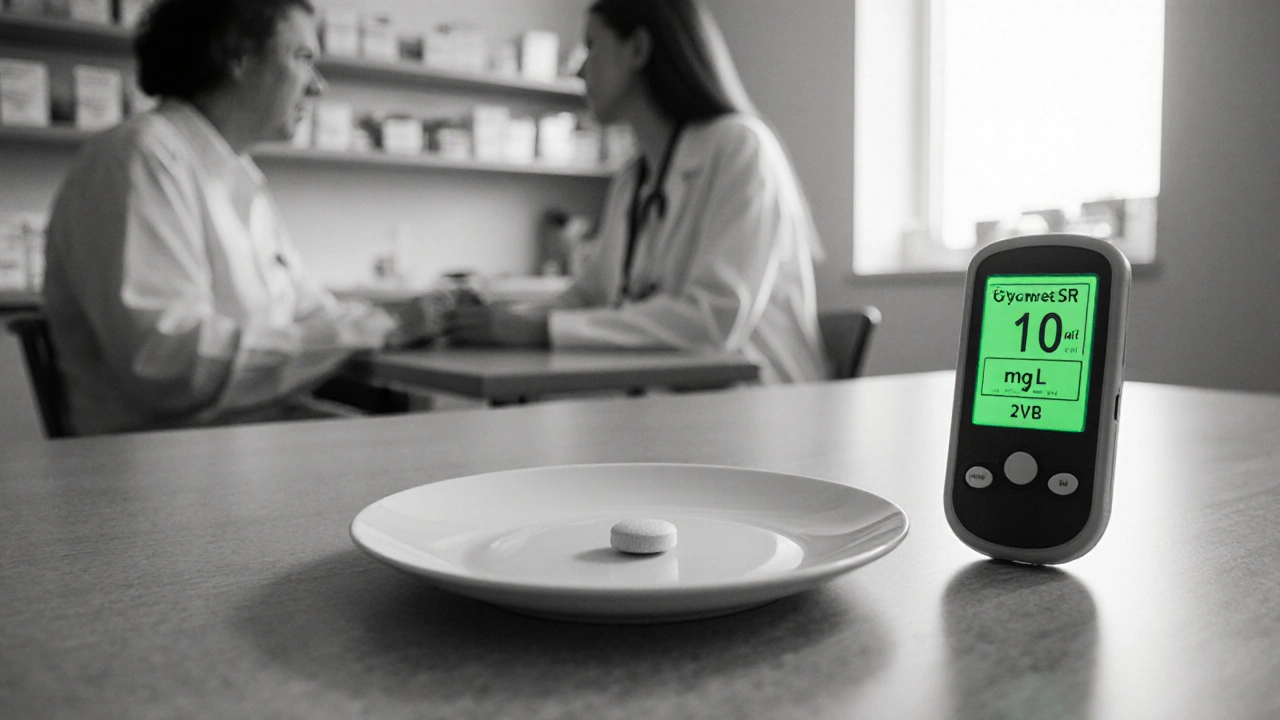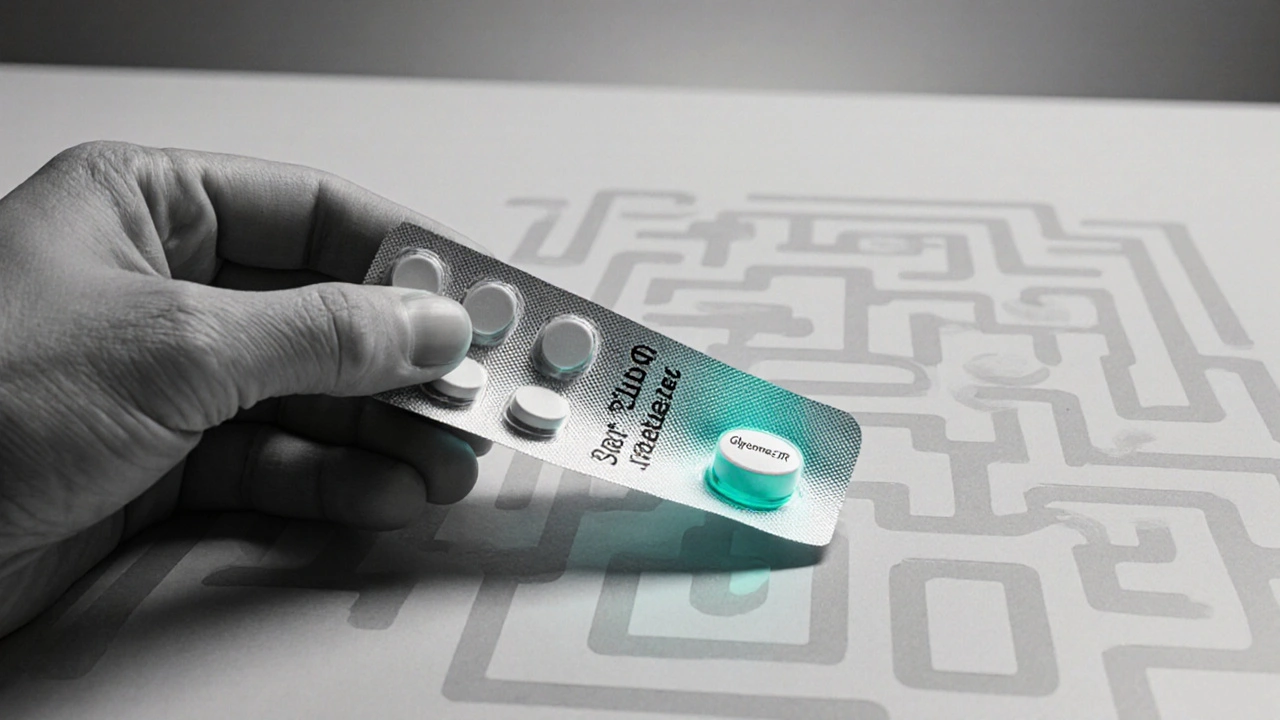Diabetes Medication Comparison Calculator
Your Health Profile
Your Personalized Results
Top Recommendations
Based on your HbA1c, weight, budget, and side-effect tolerance
Key Comparison
When it comes to managing type 2 diabetes, picking the right pill can feel like a maze. Glycomet SR is a brand‑name extended‑release (ER) formulation of metformin, the most widely prescribed oral drug for type 2 diabetes. It promises smoother blood‑sugar control with fewer stomach upsets, but how does it really stack up against the other options you’ll see on a pharmacy shelf? This guide walks you through the key differences, costs, and side‑effect profiles so you can decide if Glycomet SR is the best fit for your routine.
What exactly is Glycomet SR?
Glycomet SR contains metformin hydrochloride in a matrix that releases the drug slowly over 12‑14 hours. Most patients take one or two tablets once daily, usually with the evening meal. The “SR” stands for “sustained release,” which means the peak plasma concentration is lower and more gradual than the immediate‑release (IR) version.
- Typical dose: 500mg or 850mg per tablet
- Frequency: once daily (sometimes split into twice for higher doses)
- Key benefit: reduced gastrointestinal (GI) side‑effects such as nausea and diarrhea
How does metformin work?
Metformin belongs to the biguanide class. It primarily lowers hepatic glucose production and improves peripheral insulin sensitivity. Unlike insulin or sulfonylureas, it does not cause hypoglycaemia when used alone. This mechanism makes it a first‑line agent in most clinical guidelines.
Core criteria for comparing diabetes pills
Before we dive into the table, keep these five factors in mind. They’re the ones patients and doctors regularly weigh when choosing a regimen.
- Efficacy: Ability to lower HbA1c (the 3‑month average blood‑sugar reading).
- Dosing convenience: How many pills per day and whether food is required.
- Side‑effect profile: GI upset, weight change, risk of hypoglycaemia, etc.
- Cardiovascular impact: Some newer agents show heart‑protective benefits.
- Cost and insurance coverage in Australia.
Side‑by‑side comparison
| Medication | Formulation | Dose Frequency | Typical Cost (AU$ per month) | Common Side‑effects | Weight Impact | Cardiovascular Benefit |
|---|---|---|---|---|---|---|
| Glycomet SR | Extended‑release metformin | Once daily (with evening meal) | ≈$25‑$35 | Mild nausea, occasional diarrhea | Neutral or modest loss | Neutral (standard metformin benefit) |
| Metformin IR (e.g., Glucophage) | Immediate‑release | 2-3 times daily (with meals) | ≈$20‑$30 | Higher GI upset, metallic taste | Neutral | Neutral |
| Glucophage XR | Extended‑release (different matrix) | Once daily | ≈$30‑$40 | Similar to Glycomet SR | Neutral | Neutral |
| Sitagliptin (Januvia) | DPP‑4 inhibitor | Once daily | ≈$70‑$90 | Rare GI issues, upper‑respiratory infections | Weight‑neutral | Neutral |
| Canagliflozin (Invokana) | SGLT2 inhibitor | Once daily | ≈$90‑$120 | Genital mycotic infections, increased urination | Modest weight loss | Reduced cardiovascular death in high‑risk patients |
| Glipizide | Sulfonylurea | Once daily (often morning) | ≈$15‑$25 | Hypoglycaemia, weight gain | Weight gain | No proven CV benefit |
| Pioglitazone | Thiazolidinedione | Once daily | ≈$30‑$45 | Fluid retention, possible heart failure | Weight gain | Potential CV benefit but safety concerns |
When Glycomet SR makes sense
If you’ve tried Metformin IR and the stomach upset was a deal‑breaker, Glycomet SR is often the next step before moving to a completely different drug class. It’s also a good choice when you prefer a single‑pill‑a‑day routine.
- HbA1c reduction of ~1.0‑1.5% (similar to other metformin forms)
- Lower incidence of nausea - studies show a 30% drop versus IR
- Cost‑effective compared with brand‑name DPP‑4 or SGLT2 inhibitors
- Safe in chronic kidney disease stages3‑4 with dose adjustment
Remember, metformin is contraindicated in patients with severe renal impairment (eGFR <30mL/min/1.73m²) or acute heart failure, so discuss labs with your GP before starting.
Overview of the main alternatives
Below is a quick snapshot of when you might consider swapping Glycomet SR for another class.
- Metformin IR (Glucophage): Ideal if you need flexible dosing (e.g., 500mg three times) or if insurance only covers the IR brand.
- Glucophage XR: Same active ingredient, different release technology; choose it if you already trust the Glucophage brand but need once‑daily dosing.
- Sitagliptin: Good for patients who can’t tolerate any GI upset or who have mild renal insufficiency - it’s weight‑neutral and low hypoglycaemia risk.
- Canagliflozin: Adds heart‑failure and renal protection benefits, plus modest weight loss, but watch for urinary‑tract infections.
- Glipizide: Very cheap and effective for quick HbA1c drops, but the hypoglycaemia risk makes it less attractive for older adults.
- Pioglitazone: Consider if you have a strong insulin‑resistance component and no history of heart failure.

Switching tips and what to watch for
Changing from one oral agent to another isn’t a big deal, but a few practical steps smooth the transition.
- Check your most recent HbA1c and eGFR - the numbers guide dose adjustments.
- Gradually taper Metformin IR if you’re moving to an SGLT2 inhibitor to avoid overlapping GI side‑effects.
- Monitor blood glucose for the first two weeks; a small rise is normal as the body adapts.
- Keep a symptom diary - note any nausea, dizziness, or urinary changes.
- Schedule a follow‑up with your GP or diabetes educator after 4‑6 weeks.
Key Takeaways
- Glycomet SR offers once‑daily dosing with fewer stomach issues compared with Metformin IR.
- Its glucose‑lowering power is on par with other metformin products, but it doesn’t add the extra cardiovascular protection seen with SGLT2 inhibitors.
- Cost‑wise, it sits between cheap generic IR metformin and the pricier DPP‑4 or SGLT2 options.
- Choose alternatives like Sitagliptin or Canagliflozin when you need weight loss, heart‑health benefits, or have intolerance to any metformin.
- Always review kidney function and talk to your healthcare provider before switching.
Frequently Asked Questions
Can I take Glycomet SR with food?
Yes. Taking it with the evening meal helps reduce any remaining GI irritation and improves absorption.
How long does it take for Glycomet SR to lower my HbA1c?
Most patients see a 0.8‑1.5% reduction after 12weeks of consistent dosing, similar to other metformin formulations.
Is Glycomet SR safe during pregnancy?
Metformin is considered pregnancy‑category B and is often continued for gestational diabetes, but you should discuss any medication changes with your obstetrician.
What should I do if I miss a dose?
Take the missed tablet as soon as you remember, unless it’s close to your next scheduled dose. In that case, skip the missed one and continue with the regular schedule - don’t double‑dose.
Can I combine Glycomet SR with an SGLT2 inhibitor?
Yes, many clinicians prescribe metformin (any form) together with an SGLT2 inhibitor for additive glucose‑lowering and added heart‑protective benefits. Monitor kidney function and watch for dehydration.






Glycomet SR is like that reliable friend who shows up right when you need them, easing the sugar roller‑coaster without demanding a banquet of pills. Its extended‑release matrix smooths out those post‑meal spikes, which is a breath of fresh air for anyone battling the usual metformin pangs. And the price tag? Still modest, especially when you compare it to the pricey DPP‑4 or SGLT2 crowd. Bottom line: it’s a solid, low‑key champion in the diabetes toolbox.
Wow, the world of metformin is a never‑ending saga.
From a pharmacokinetic standpoint, the biphasic absorption profile of Glycomet SR attenuates the peak‑to‑trough variability inherent to immediate‑release formulations, thereby reducing the incidence of dose‑related gastrointestinal adverse events. Moreover, the matrix‑based dissolution mechanism follows a zero‑order kinetic release, which aligns with the therapeutic window required for optimal hepatic gluconeogenesis suppression. Clinical trial data indicates a mean HbA1c decrement of 1.2 % over a 24‑week period, on par with standard metformin IR yet with a 30 % reduction in reported nausea episodes. The extended‑release matrix also mitigates the risk of lactic acidosis in patients with mild to moderate renal impairment, provided dosing adjustments are observed in accordance with eGFR thresholds. Cardiovascular outcome trials have consistently demonstrated neutral effects for metformin analogues, distinguishing them from the SGLT2 class which exhibit pronounced mortality benefits. Cost‑effectiveness analyses reveal that Glycomet SR, when juxtaposed against branded DPP‑4 inhibitors such as Sitagliptin, offers a favorable incremental cost‑utility ratio, often falling below the willingness‑to‑pay threshold of AU$50,000 per QALY. The drug‑drug interaction profile remains relatively benign, with negligible cytochrome P450 inhibition, thus simplifying polypharmacy regimens in comorbid populations. In terms of formulation stability, the osmotic pump design preserves drug integrity across a broader temperature spectrum, an advantage for patients in tropical climates. Adherence metrics improve as once‑daily dosing reduces pill fatigue, a phenomenon well‑documented in the adherence literature. However, clinicians must remain vigilant regarding contraindications in advanced chronic kidney disease stages, where dose reductions or discontinuation become imperative. Prescription guidelines also advise titration over a 2‑to‑4‑week interval to further curtail gastrointestinal discomfort, a protocol that aligns with patient‑centred care models. Patient-reported outcome measures frequently highlight enhanced quality‑of‑life scores, reflecting the psychological benefit of fewer dosing events. It is noteworthy that the extended‑release formulation does not substantially alter the drug’s impact on weight, maintaining the neutral weight profile characteristic of metformin. Finally, real‑world evidence from observational databases corroborates the randomized trial findings, cementing Glycomet SR’s position as a cost‑effective, efficacious, and tolerable first‑line therapy.
Considering the pharmacodynamic synergy-particularly the AMPK activation pathway-Glycomet SR offers a nuanced modulation of hepatic glucose output; however, the therapeutic index remains comparable to its immediate‑release counterpart, and clinicians should therefore evaluate patient‑specific tolerance thresholds, especially in regard to gastrointestinal sequelae, before committing to a regimen shift.
Glycomet SR can be a good step if the IR version gives you stomach trouble.
Oh, absolutely, because nothing screams “cutting‑edge medicine” like taking the same old metformin molecule and slapping an “SR” label on it-just marvelously innovative, right? Yet if you actually read the data, you’ll see the glycemic drop is virtually identical, and the only real perk is that you might dodge a few extra trips to the bathroom. Sure, the once‑daily dosing is convenient, but convenience isn’t a substitute for a drug that genuinely reduces cardiovascular risk beyond the baseline metformin effect. In the grand scheme of the diabetes pharmacopeia, Glycomet SR is more of a modest convenience tweak than a revolutionary breakthrough. It does, however, keep the price tag in check, sparing you the steep out‑of‑pocket costs of newer agents like GLP‑1 agonists, which many patients can’t afford. So, if you’re looking for a practical, budget‑friendly option that slides neatly into your existing regimen, it certainly earns a nod. Otherwise, you might be better off exploring alternatives that offer tangible weight loss or proven heart‑health benefits. Bottom line: it’s a solid, if unspectacular, tool in the therapeutic toolbox.
Don’t let Pharma’s marketing fluff convince you that SR is some secret weapon-it's the same old metformin with a fancy coating! 💊🚫 The real agenda is to keep us buying brand‑name pills while the generic IR does the same job for pennies. Stay woke! 👀💥
Well, if you’re okay with paying a tad extra for a pill that just releases slower, go ahead. Otherwise, the cheap IR does the job-no need to make a drama out of it.